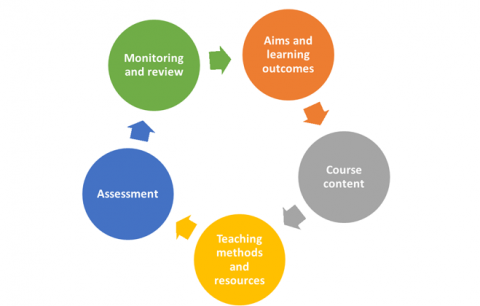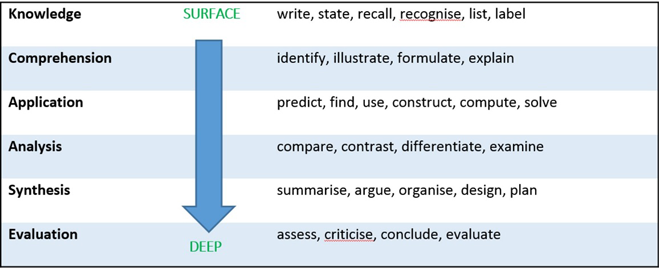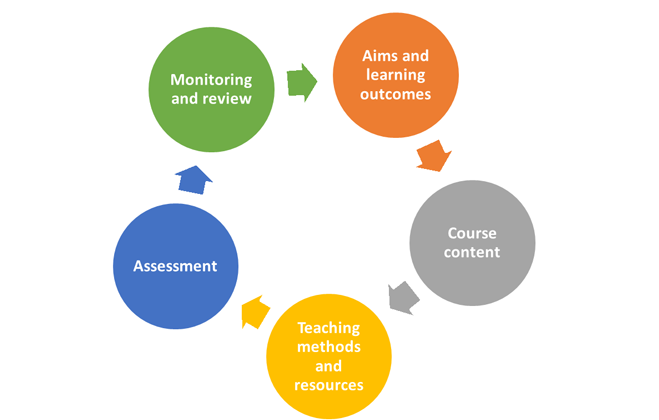How to Design Effective Teaching Modules
Amy Burge shares three key things to think about when designing successful modules and courses.
Having the opportunity to design a whole module or course in higher education can seem simultaneously daunting and exciting. Susan Toohey explains that:
 How different elements of a module fit together.
How different elements of a module fit together.
Teachers in Higher Education retain a very significant advantage over teachers in other branches of education: their control over the curriculum… Much of the creativity and power in teaching lies in the design of the curriculum; the choice of texts and ideas which become the focus of study, the planning of experiences for students and the means by which achievement is assessed… Of course the way in which the curriculum is brought to life is equally important, but the power of good teacher-student interactions is multiplied many times by good course design. (from Susan Toohey, Designing Courses for Higher Education, p.1.)
Designing modules is a great privilege, but also a responsibility. It can be difficult, when starting out designing modules, to know where to begin. For me, there are three key things to think about when designing a module that you can apply to any teaching subject.
1. Be clear about the module purposes and aspirations for student participants and communicate these to students.
It’s important to have clear, achievable goals or outcomes for your module. What do you want students to know, understand and/or be able to demonstrate after they complete your module? We would usually call these aims learning outcomes or objectives. Learning outcomes are statements of what skills, knowledge, or learning a student will have once they have completed the module.
Many learning objectives are based on a hierarchical model of learning first articulated by Bloom in the 1950s. Bloom’s model has been critiqued and modified since then, but it is still useful for thinking about learning outcomes.

Bloom categorises learning into gradually increasing levels of sophistication, beginning with surface learning skills, such as recall of information, moving to deeper learning skills of assessment and evaluation. Typical learning outcomes for a module might map onto Bloom’s hierarchy, indicating the development of learning over the course of the module.
2. Make sure your module is constructively aligned (the learner actively constructs their own understanding and all teaching and assessment is aligned with the intended outcomes)
A successful module is one in where the stated learning outcomes or objectives align with teaching activity and assessment (what has been called constructive alignment). In other words, in the context of the learning outcomes, what learning activities do you want your students to engage with? What kinds of activities would lead to achieving the learning objectives? What content will be needed to achieve learning outcomes? What support will the learners need to achieve the learning outcomes? What is the best way to assess how far students have achieved the learning outcomes? How might you review or evaluate the course to find out if it has successfully aligned learning outcomes with activity and assessment?
The image below is useful for thinking about how the different elements of a module fit together in constructive alignment.

3. Considering the course in context (department, institution, sector)
Finally, it’s important to think about what might affect the design of a module in your context. This is likely to change the way you think about designing outcomes, learning activities, and assessment. Think about:
- The type of course (How long is the course? How many students? What level (e.g. undergraduate or postgraduate)? What type of students (e.g. visiting students, practitioners)?
- The resources available (Who is involved? How are roles allocated? What administrative support is available?)
- Your disciplinary context (how is the subject normally taught in your discipline? Are there any broader structures to consider (e.g. professional bodies that accredit courses)?
- National and legal requirements (Equality and diversity legislation; UK academic infrastructure and internal requirements).
Designing your own modules is a hugely rewarding experience and I hope that these three key tips will be helpful for your future planning.
References:
Toohey, S. (1999) Designing Courses for Higher Education. Buckingham: Society for Research into Higher Education and Open University Press.

